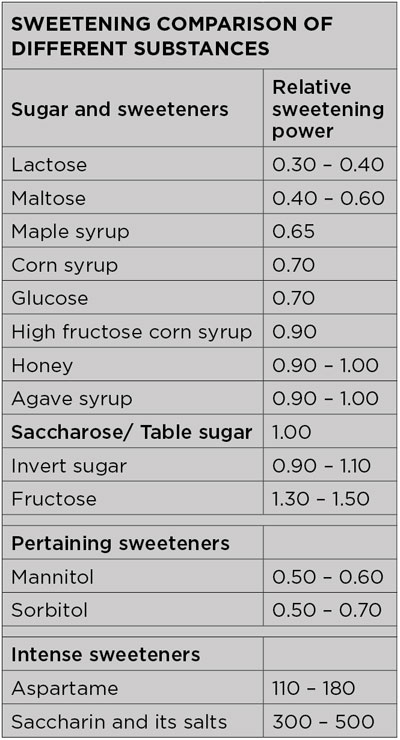
Tricks of the Trade: May 2011
May 2, 2011
By
FORMA-LAB
Humans are born to like sweet tastes, favouring them over acidic, bitter and very salty foods. There are lots of sources of sweetness, the best known of which is sugar. Sugar, also known as carbohydrates, comes mostly from sugar cane or sugar beets and is a key ingredient used by much of the food industry. On average, sugar supplies 15 per cent of our daily calories.
Humans are born to like sweet tastes, favouring them over acidic,
bitter and very salty foods. There are lots of sources of sweetness,
the best known of which is sugar. Sugar, also known as carbohydrates,
comes mostly from sugar cane or sugar beets and is a key ingredient
used by much of the food industry. On average, sugar supplies 15 per
cent of our daily calories.
Fine or extra fine sugar is the most important one used in the baking
industry. Coarse sugar is used for decoration, while fruit sugar is
used in pastry. Powder sugar contains three to five per cent starch and
is mostly used for icing and pastries.
Brown sugar is made by adding molasses to white sugar at different
levels, according to your needs. Brown sugar comes in golden or dark
varieties. It is used in baking grain breads, cookies, muffins and
other goods. When working with brown sugar, you must be aware of the
colour it will bring to your finish product.
The quantities of the various sugars in your formulations will
determine the structure and the organoleptic characteristics relating
to the senses (touch, taste, sight, smell). Cakes, cookies and breads
require sugars to give them great flavour, nice colour and a uniform
grain. Sugars also help these products keep humidity and increase their
shelf life.
The type of sugar used will vary according to the baking product. But
remember, sugar isn’t the only source of sweetness you can turn to for
your baking needs.
Working with sugars
There are two types of colour reactions that are important to be aware of when working with sugar.
In the first, reaction sugar is heated and transformed into a golden
substance ranging from pale to dark, and with soft to medium flavour.
At 186 C, sugar melts, bringing out an interesting flavour and
exquisite aroma. This product that results from the sugar degradation
is called caramel, and the process is called caramelization.
Caramelization depends on the type of oven used, baking temperature,
humidity, pH of the dough, and activity of the flour enzymes.
The second type of colour reaction, known as the Maillard reaction,
results in baked products darkening as the sugar they contain reacts
during the baking process.
Both reactions need heat; they are not enzymatic. Note that caramelization requires more heat than the Maillard reaction.
Swapping out sugars
If you’re looking to produce sugarless products or replace processed
sugars with a natural sweetener, there are several options to consider.
Honey is the only sweetener that does not require transformation before
consumption and is therefore considered a natural sugar. Agave nectar
is another option for sugar replacement. Consisting primarily of
fructose and glucose, agave nectar is slightly thinner than honey. It
ranges in colour from light to dark amber, depending on the degree of
processing it has undergone.
The sweetness of sugars and various other sweeteners is measured on a
relative scale. Table sugar (saccharose) is assigned a value of 1.00.
Sugars and sweeteners with a value below that are less sweet than table
sugar, while those with values above 1.00 are more sweet than table
sugar. If you want to substitute sugar entirely or in part with another
sweetener, it is important to understand how the sweetness of your
substitute stacks up against the sugar called for in your formulation.

|
This table provides a comparison of several different sweeteners and sugars.
Fruit purees are good choices to replace sugar in pastries. As you
know, a sugar-free bread is usually very crusty, so replacing or
reducing sugar is usually an option more successfully employed in
pastry. The sweeter fruit puree come from dates, dry raisins, apricots,
peaches, prunes and plums. Also, when replacing sugars with fruit
puree, you have to consider the colour that the puree source will add
to your product.
Of course you can reduce the sugar in any baked product, but you must
remember that this will have an effect on the moisture and the shelf
life of the product. For example, you can make fruit filling without
the addition of sugar, but your filling will have a short shelf life
and you may have problems with overflow during baking. You will have to
add some starch, gums or pectin to get the proper finished product.
Mario Fortin is an international bakery
consultant and owner of FORMA-LAB, a consulting service to bakers and
suppliers. If you have a technical problem, send your questions to
info@forma-lab.com.
Print this page
Leave a Reply